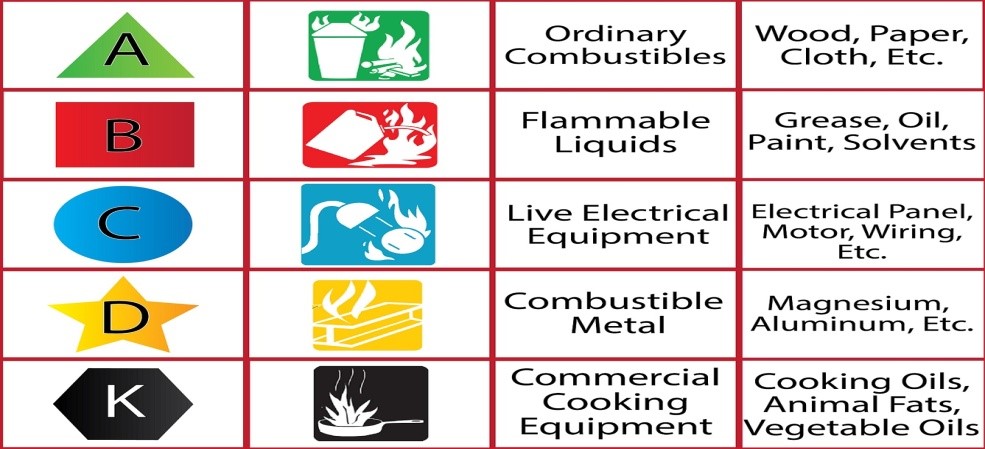TYPES OF FIRE
“Fire is danger”. INDEED it’s a dangerous element and terrifies to have any bad experience through it. Scientifically fires are neither solid nor liquid and also not like gas because gas can exist in the air but fire always burn out sooner or later. The fire actually is a combination of three substances that is, oxygen, heat, and fuel. This is also called a “fire triangle”. In simple words a process in which these three substances combine causes burning or combustion.

Different classes of fire are discussed below
•Class A Ordinary combustible
•Class B Flammable liquids or gases
•Class C Live electrical equipment
•Class D Combustible metal
•Class K Cooking equipment
CLASS A: ORDINARY COMBUSTIBLE
Class A fire includes solid combustible material such as paper, wood, trash, cloth, or plastic. It is the most common type of fire we all know about. This type of fire usually found in offices, schools, and retail outlets because these places carry many amounts of textiles and papers. We also make class A fire intentionally by lighting the match or lighter for cooking. It also catches homes due to the improper use of cigarettes, lighters, heaters, and candles.
Each type of fires is risky but class A fire is easy to extinguish. Equipment that tackles class A fire are water extinguisher, powder extinguisher, and foam extinguisher. Class A fire is also a useful source to have heat and light.
A simple way to avoid class A fire is to place paper, textile, wood or piles of waste far away from any possible source which can start a fire
CLASS B: FLAMMABLE LIQUIDS OR GASES
Class B fire involves flammable liquid and gases like petroleum grease, paint, alcohol, kerosene, propane, or gasoline. Cooking oil or grease is not part of this class of fire. Places, where flammable liquids or gases are used or stored, might get caught by this class of fire.
Class B fire carries oxygen, and to dilute oxygen to can use carbon dioxide gas to stop burning. You can use powder, foam, or carbon dioxide extinguisher to tackle this class of fire. A water extinguisher is prohibited to use class B fire because the watercourse might expand the flaming material rather than extinguish it.
Never refill gasoline-powered equipment in the presence of an open flame, limited space or when it is hot and always store flammable liquids in a container that close tightly and will not leak.
CLASS C: LIVE ELECTRICAL EQUIPMENT
This is another dangerous class of fire and is very common in both homes and industries. This sort of fire gets started as the result of broken electrical fittings, old wires, or any electrical equipment, motors, cables, or wires when get overheated, overcharged, or overloaded then cause a short circuit or spark. Electricity cannot burn itself the item amount the electrical source can ignite the oil and dust in it.
We cannot fight class C fire from water, it makes the situation more dangerous especially for firefighters. The presence of electricity in a fire can pass through water to the body of firefighters which give unbearable electrical shocks. These fires can be tackled by using a carbon dioxide or dry powder fire extinguisher. Once the power source is disconnected to the equipment involved it will become an ordinary class A type of fire and will tackle easily.
You must be careful whenever you get a Class C fire never try to fight it with water and immediately turn off the main power source if it is possible and safe to do.
CLASS D: COMBUSTIBLE METALS
Class D fire cases are rare and it usually occurs in industries. It may cause by combustible metals such as alkali metals like potassium and lithium and other metals and elements like magnesium, aluminum, sodium, titanium, and zirconium as these can ignite when exposing to air and water. Combustible metal fire is rare that’s why people are often not aware of this type of fire and are not properly prepared to fight them therefore even a small metal fire can spread and become more dangerous.
This type of fire burns in contact with air or water so water and other common firefighters can increase and spread metal fire and make them worst. To overcome class D fire dry powder extinguishers are recommended which can absorb heat. Different agents of dry powder use to fight for different metals. One particular metal agent may not necessary to be a substitute for another one. Commonly use agents are sodium chloride, copper, and graphite powder.
CLASS K: COOKING EQUIPMENT
Class K is an extremely common type of fire and important enough to discuss it separately. The causes of this fire include in our daily routine while cooking.
It may start by leaving the pan unattended on the burning stove or oil and greases reach a high temperature as it always does in the kitchen can easily ignite this type of fire. It is very common but can give a serious injury because it takes just 30 minutes for a flame to spread and become devasting.
Never try to fight cooking oil fire from water it can spread more like this. It is mandatory to keep wet chemical extinguisher to tackle this type of fire. If you are not capable enough to fight this fire immediately evacuate from the place.
